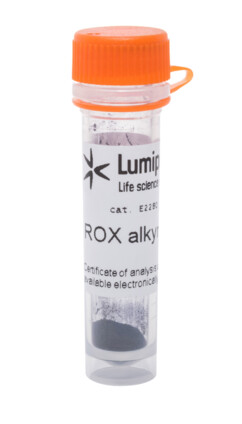Perylene azide
| Cat. # | Quantity | Price | Lead time | Buy this product |
|---|---|---|---|---|
| A5530 | 1 mg |
please inquire
|
in stock (2 pcs) | |
| B5530 | 5 mg |
please inquire
|
in stock (2 pcs) | |
| C5530 | 10 mg |
please inquire
|
in stock (3 pcs) | |
| D5530 | 25 mg |
please inquire
|
in stock (2 pcs) | |
| E5530 | 50 mg |
please inquire
|
in stock (2 pcs) |

This product will be discontinued soon. We may still have some material in stock (please see availability above).
Perylene is a bright and extremely photostable fluorescent polycyclic aromatic hydrocarbon (PAH) label with quantum yield approaching quantitative.
Due to low life time of fluorescence, this probe does not form excimers.
Perylene labeling of biomolecules is used to be difficult and tedious because of low solubility of perylene, and low availability of activated derivatives. However, labeling via Click Chemistry with this perylene azide is nearly as easy, as with other dyes. Labeling peptide, DNA, protein with this polyaromatic hydrocarbon has never been so simple yet.
To increase hydrophilicity, and facilitate labeling, this PAH azide contains hydrophilic triethyleneglycol linker.
Perylene absorption and emission spectra

Customers also purchased with this product
General properties
| Appearance: | orange-yellow solid |
| Molecular weight: | 452.50 |
| CAS number: | 1807503-81-6 |
| Molecular formula: | C27H24N4O3 |
| IUPAC name: | 3-(8-Azido-3,6-trioxaoctylaminocarbonyl)perylene |
| Solubility: | good in dichloromethane and chloroform, moderate in DMSO, DMF, and acetonitrile |
| Quality control: | NMR 1H (95%) |
| Storage conditions: | Storage: 24 months after receival at -20°C in the dark. Transportation: at room temperature for up to 3 weeks. Avoid prolonged exposure to light. |
| MSDS: | Download |
| Product specifications |
Spectral properties
| Excitation/absorption maximum, nm: | 435; 408; 252 |
| ε, L⋅mol−1⋅cm−1: | 36000 |
| Emission maximum, nm: | 439; 467 |
| Fluorescence quantum yield: | 1.0 |
Product citations
- Bednarczyk, M.; Peters, J.K.; Kasprzyk, R.; Starek, J.; Warminski, M.; Spiewla, T.; Mugridge, J.S.; Gross, J.D.; Jemielity, J.; Kowalska, J. Fluorescence-Based Activity Screening Assay Reveals Small Molecule Inhibitors of Vaccinia Virus mRNA Decapping Enzyme D9. ACS Chemical Biology, 2022, 17(6), 1460-1471. doi: 10.1021/acschembio.2c00049
- Epanchintseva, A. V.; Gorbunova, E. A.; Ryabchikova, E. I.; Pyshnaya, I. A.; Pyshnyi, D. V. Effect of Fluorescent Labels on DNA Affinity for Gold Nanoparticles. Nanomaterials, 2021, 11(5), 1178. doi: 10.3390/nano11051178
- Taskova, M.; Astakhova, K. Fluorescent Oligonucleotides with Bis(prop-2-yn-1-yloxy)butane-1,3-diol Scaffold Rapidly Detect Disease-Associated Nucleic Acids. Bioconjugate Chemistry, 2019, 30(12), 3007–3012. doi: 10.1021/acs.bioconjchem.9b00746
- Westergaard Mulberg, M.; Taskova, M.; Thomsen, R.P.; Okholm, A.H.; Kjems, J.; Astakhova, K. New Fluorescent Nanoparticles for Ultrasensitive Detection of Nucleic Acids by Optical Methods. Chembiochem, 2017, 18(16), 1599–1603. doi: 10.1002/cbic.201700125

























 $
$ 
